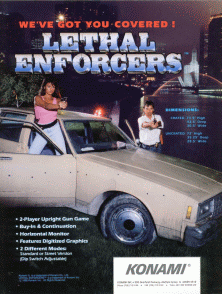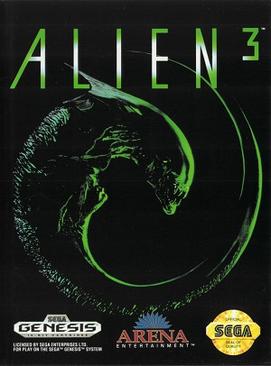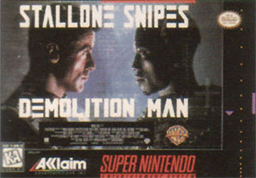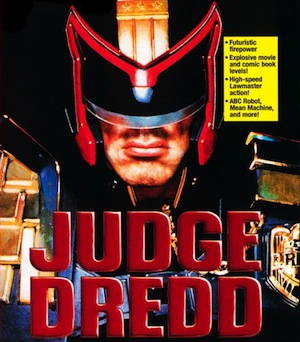
Earthworm Jim is a 1994 run and gun platform game developed by Shiny Entertainment, featuring an earthworm named Jim, who wears a robotic suit and battles the forces of evil. The game was released for the Sega Genesis and Super Nintendo Entertainment System, before being subsequently ported to a number of other video game consoles.

NBA Jam is a basketball video game developed and published by Midway for arcades in 1993. It is the first entry in the NBA Jam series. The project leader for this game was Mark Turmell.

Venom/Spider-Man: Separation Anxiety is a side-scrolling beat 'em up video game and a sequel to Spider-Man and Venom: Maximum Carnage, released for Mega Drive/Genesis and Super NES and then ported to PC. One or two players team up as Spider-Man and Venom to defeat the evil symbiote Carnage. The game boasts many thugs that the player has to defeat: heavily armed Jury and Venom's symbiote children. There is also cameo assistance from Captain America, Ghost Rider, Hawkeye, and Daredevil.

Shaq Fu is a 2D fighting game published by Electronic Arts for the Sega Genesis and Super NES on October 28, 1994. It was developed by Delphine Software International. Versions for the Game Gear, Game Boy, and Amiga followed in 1995. Former professional basketball player Shaquille O'Neal is the player character.

Lethal Enforcers is a 1992 light gun shooter released as an arcade video game by Konami. The graphics consist entirely of digitized photographs and digitized sprites. Home versions were released for the Super NES, Genesis and Sega CD during the following year and include a revolver-shaped light gun known as The Justifier.

WWF WrestleMania is a professional wrestling arcade game released by Midway Manufacturing Co. in 1995. It is based on the World Wrestling Federation (WWF) professional wrestling promotion.

RoboCop 3 is a video game based on the 1993 film of the same name. Amiga, Atari ST and DOS versions were developed by Digital Image Design beginning in September 1990, and published by Ocean Software in December 1991. The Digital Image Design version includes multiple gameplay styles. During 1992 and 1993, other versions consisting of side-scrolling platform gameplay were released for the Commodore 64, ZX Spectrum, NES, Super NES, Game Gear, Master System, and Sega Genesis.

The Lion King is a platform game based on Disney's 1994 animated film The Lion King. The game was developed by Westwood Studios and published by Virgin Interactive Entertainment for the Super NES and Genesis in 1994, and was ported to MS-DOS, Amiga, Game Gear, Master System, and Nintendo Entertainment System. The Amiga, Master System, and NES versions were only released in the PAL region. It is the final licensed NES game worldwide. The game follows Simba's journey from a young cub to the battle with his uncle Scar as an adult.

Barkley Shut Up and Jam! is a basketball video game originally developed and published by Accolade for the Sega Genesis on North America in 1993 and later in Europe in April 1994. The game is the first entry in the Barkley Shut Up and Jam series, featuring former NBA MVP Charles Barkley prominently and as one of the playable characters.

Alien 3 is a run and gun game based on the 1992 film of the same name. It was released for the Genesis and Amiga in 1992, then for the Commodore 64, Game Boy, Game Gear, Nintendo Entertainment System, Super Nintendo Entertainment System, and Master System.

The Adventures of Batman & Robin is a series of video game adaptations released between 1994 and 1995 featuring the DC Comics characters Batman and Robin based on Batman: The Animated Series. The games were released for numerous platforms, with the Genesis, Game Gear, and Sega CD versions published by Sega while the Super NES version was published by Konami.

Demolition Man is a pair of action video games based on the film of the same name. Acclaim Entertainment published the 16-bit version, which features run and gun gameplay, for the Super NES, Sega Genesis and Sega CD. Virgin Interactive released a completely different game for the 3DO that combined several distinct gameplay styles. In both games, the player controls John Spartan, the main character from the film, as he attempts to find and defeat his nemesis, Simon Phoenix.

True Lies is a top-view run and gun video game based on the 1994 film True Lies. The game was developed by Beam Software and published by Acclaim Entertainment. Four different versions of the game were released for the Super Nintendo Entertainment System, Sega Genesis, Game Gear, and Game Boy. The home versions and portable versions are drastically different from each other, but have similar play mechanics.

Dragon: The Bruce Lee Story is a fighting video game developed and originally published by Virgin Interactive Entertainment in Europe for the Sega Genesis in June 1994. It is based on the 1993 film of the same name, which is a semi-fictionalized account of the life of Hong Kong-American actor and martial artist Bruce Lee. Following the events of the movie, players take control of Bruce Lee across several stages that takes places in different time periods of his life and fight against some of his adversaries.

Judge Dredd is a side-view action video game released for the Super NES, Mega Drive/Genesis, Game Gear and Game Boy originally released in 1995. The game is based on the 1995 film Judge Dredd, which was itself an adaptation of the Judge Dredd strip from 2000AD.

PGA Tour 96 is a sports video game developed by Hitmen Productions for the PlayStation, MS-DOS, and Windows versions, Unexpected Development for the Game Boy version, NuFX for the Sega Genesis and 3DO versions, Ceris Software for the Game Gear version, and Polygames for the SNES version and published by EA Sports for PlayStation, MS-DOS, Windows, Game Boy, Sega Genesis, 3DO, Game Gear and SNES.

Brett Hull Hockey '95 is an ice hockey simulation video game released in January 1995 for multiple platforms; including the Super Nintendo Entertainment System, Sega Genesis, and personal computers running DOS.

Mighty Morphin Power Rangers: The Movie is the title of four different video game adaptations of the film of the same name which were released for the Super NES, Genesis, Game Boy and Game Gear. While the games are ostensibly based on the film, they also feature characters and plot elements from the second season of the original TV series. Like the previous game versions of the original Mighty Morphin Power Rangers, none of the four versions of the movie game are ports of each other.

Mortal Kombat is a 1992 fighting game developed and published by Midway. It is the first entry in the Mortal Kombat series and was subsequently released by Acclaim Entertainment for nearly every home platform at that time. The game focuses on several characters of various intentions who enter a martial arts tournament with worldly consequences. It introduced many key aspects of the Mortal Kombat series, including the unique five-button control scheme and gory finishing moves called Fatalities.

NFL Quarterback Club 96 is an American football video game released in December 1995. The game was released on the Sega Saturn, Sega Genesis, Game Boy, Sega Game Gear, DOS, and Super Nintendo Entertainment System. The game's cover features San Francisco 49ers quarterback Steve Young passing while being tackled by Chicago Bears defensive linemen Chris Zorich and Albert Fontenot. The Saturn, Genesis, SNES and DOS versions were developed by Iguana Entertainment, while the Game Boy and Game Gear edition was developed by Condor Inc.


















